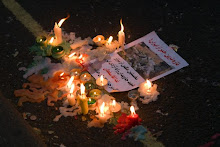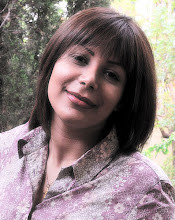


If you want to get completely lost in a Degree Show, this is the place to do it. Camberwell always was a warren and it hasn’t changed. Once you’re in, it’s near impossible to find any way out.
But here I am and none the worse for it. Camberwell ceramics degree show was an optimistic affair. The only dedicated ceramics undergraduate course left in London, it marches on regardless. This was the final year for that spirited group known as Buff, (see labels on the right for commentary of the Buff Extravaganza Spring 2008). Their degree show, though individual now rather than a group endeavour as before, very much fulfilled the promise suggested by Buff.
Mud Larks, Party Frocks and Headless Chickens and Well'ard Angles.
Julia Kubik had become a mud lark and collected Thames detritus in the form of clay-pipe stems, washed up on the pebbly shores of the mighty London river. (Btw, these are tabacco pipe-stems for that archaic act of smoking.) These she had threaded singly so they all hung from the ceiling in a carefully graded, bristling mass, from charcoal grey to almost white, like a cloud, recalling the smoke from the pipes and the mist over the Thames. Philip Li had moved on from curling eyelashes and white cups with water-melon pink liquid to well-‘ard, block rocking, angular lumps of fired clay arranged on steel shelving in a cavernous recess all set about with dials and instruments of industrial might. A photograph called Statue shows him on a plinth with fired clay shoulder addition, surrounded by lights. This looked like the lab or den in which he, the statue, was constructed, slightly frankensteinish and fiendish.
Rebecca Fairman’s journey through the less charming side of family life continued and developed. The bed appeared again, but is context made it appear completely different, more benign, more innocent perhaps. At the end of the bed hung a slinky gown constructed of hundreds of tiny ceramic pieces – the top made of mottled glazed ceramic orange peelings, shrivelling at the edges, and the skirt of very smoothly glazed, blistering red peppers. The acidic, bitter, burning apparel in orange and red suggested a glamorous but distant, maybe slightly vicious character, less innocent-looking than the bed anyway.
Some inverted chickens with gold legs and their heads in layers of foam / fibreglass or similar, sprinkled beneath with blue dropping was both funny and slightly horrifying. And there was much much more. Degree shows are a moment of concentrated anarchy and a moment when the students get a chance to show their work as they want it seen, before the curators and institutions get hold of them and start of mould them in a career-shaped candidate.
Which leads me neatly on to New Designers.
The first impression of New Designers is one of an overdose of very nice clean stuff. I looked only at the ceramics and that was nice and clean too. This, I think, is my highly inexpert, defining word for Design – with a capital D - Clean, and Tidy. The exhibition spaces are, as someone put it, ‘like little shop fronts.’ It suits some stuff, but really doesn’t suit the stuff which isn’t design – or that’s manky or just needs a dirty space. Fairman’s bed is a perfect example of this, incidentally. I’ve seen it in three contexts now and it definitely isn’t a product – it’s a story, or rather it’s many stories, and quite literary ones at that. It thrives in an entirely different context. ND is for products. Nothing else really works. The Westminster and Camberwell shows did not, this year, specialise in products and, in most cases, the work suffered in this somewhat stifling environment. Much of it could hold its own, but I’d seen it look so much better elsewhere. See labels in right hand column, ‘Rebecca Fairman’ and ‘Buff’ and you’ll see what I mean. Perhaps it’s time for the New Designers stranglehold on craft disciplines to be broken.
Socially very fully engaged practice.
I’m not overly interested product design, not even product design that’s been reinvented as art, Lamp-Kebab notwithstanding, so I’ll select the one work that really grabbed me. Step forward Laura Masson, www.lmceramics.co.uk . Laura works directly in consultation with children in the development of her work. Her entire degree, show included, was a collaborative project with various children’s groups and organisations. The results and the thinking that is part of it are stunning. Firstly, not only are children allowed to play with porcelain, PORCELAIN, - don’t you just love it? – they’re actively encouraged to take part in the design and development of these things. Then they play with them to their hearts’ content, while contributing to further design developments. Risk is encouraged, breakage not a cause for anxiety, and their own care and manual dexterity is developed along the way. Having spent much of an afternoon involving myself with the social aspects of craft at the Jerwood do, here was an object lesson in how to do just that, as well being the only example I’ve ever seen of porcelain as a voice for one of the world’s most marginalised social groups– now how subversive is that?!












































